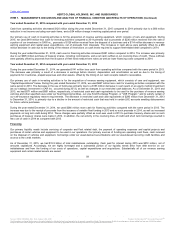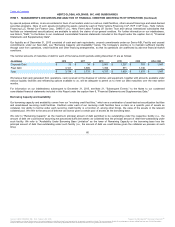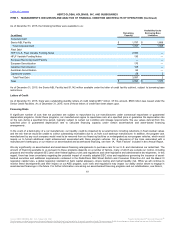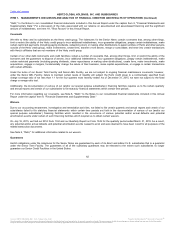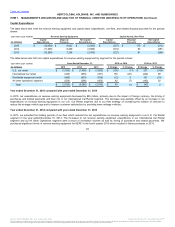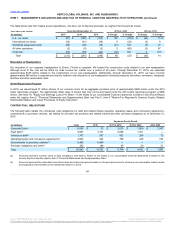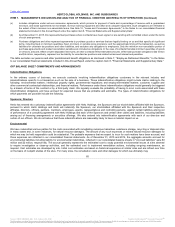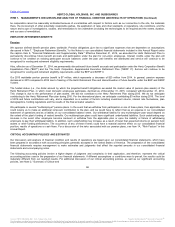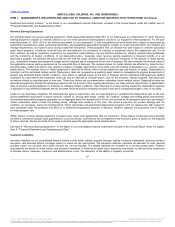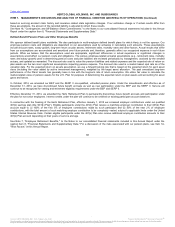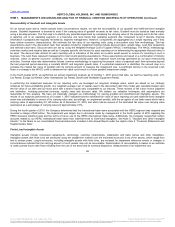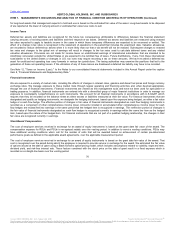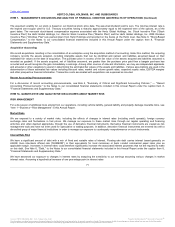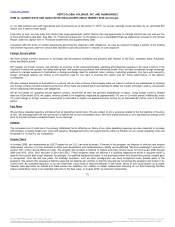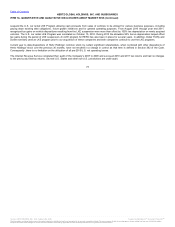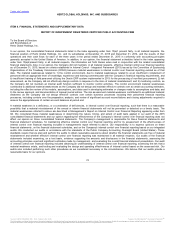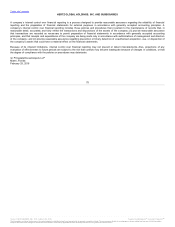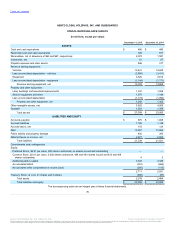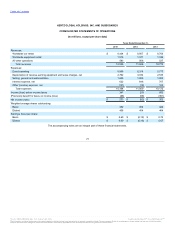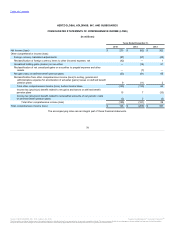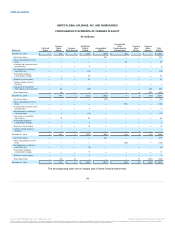Hertz 2015 Annual Report Download - page 77
Download and view the complete annual report
Please find page 77 of the 2015 Hertz annual report below. You can navigate through the pages in the report by either clicking on the pages listed below, or by using the keyword search tool below to find specific information within the annual report.
Table of Contents
On an annual basis and at interim periods when circumstances require, we test the recoverability of our goodwill and indefinite-lived intangible
assets. Goodwill impairment is deemed to exist if the carrying value of goodwill exceeds its fair value. Goodwill must be tested at least annually
using a two-step process. The first step is to identify any potential impairment by comparing the carrying value of the reporting unit to its fair value.
A reporting unit is an operating segment or a business one level below that operating segment (the component level) if discrete financial
information is prepared and regularly reviewed by segment management. However, components are aggregated as a single reporting unit if they
have similar economic characteristics. We estimate the fair value of our reporting units using a discounted cash flow methodology. The key
assumptions used in the discounted cash flow valuation model for impairment testing include discount rates, growth rates, cash flow projections
and terminal value rates. Discount rates are set by using the Weighted Average Cost of Capital (“WACC”) methodology. The WACC methodology
considers market and industry data as well as Company specific risk factors for each reporting unit in determining the appropriate discount rates to
be used. The discount rate utilized for each reporting unit is indicative of the return an investor would expect to receive for investing in such a
business. The cash flows represent management's most recent planning assumptions. These assumptions are based on a combination of industry
outlooks, views on general economic conditions, our expected pricing plans and expected future savings generated by our past restructuring
activities. Terminal value rate determination follows common methodology of capturing the present value of perpetual cash flow estimates beyond
the last projected period assuming a constant WACC and long-term growth rates. If a potential impairment is identified, the second step is to
compare the implied fair value of goodwill with its carrying amount to measure the impairment loss. A significant decline in the projected cash
flows or a change in the WACC used to determine fair value could result in a future goodwill impairment charge.
In the fourth quarter 2015, we performed our annual impairment analysis as of October 1, 2015 and at that date, we had five reporting units: U.S.
Car Rental, Europe Car Rental, Other International Car Rental, Donlen and Worldwide Equipment Rental.
In performing the impairment analyses for our reporting units, we leveraged our long-term strategic plans, which are based on our strategic
initiatives for future profitability growth. Our weighted average cost of capital used in the discounted cash flow model was calculated based upon
the fair value of our debt and our stock price with a debt to equity ratio comparable to our industry. These reviews of fair value involve judgment
and estimates, including projected revenues, royalty rates and discount rates. We believe our valuation techniques and assumptions are
reasonable for this purpose. We have not materially changed our methodology for valuing goodwill and indefinite-lived intangible assets. The
results of our analyses performed as of October 1, 2015 indicated that the estimated fair value of each reporting unit and indefinite-lived intangible
asset was substantially in excess of its carrying value and, accordingly, no impairment existed, with the exception of one trade name which had a
carrying value of approximately $1,140 million as of December 31, 2015, and which had an excess of the estimated fair value over carrying value
(expressed as a percentage of carrying value) of approximately 2.6%.
During the fourth quarter of 2015, the Company determined that the international trade name associated with the HERC segment was impaired and
recorded a charge of $40 million. The impairment was largely due to decisions made by management in the fourth quarter of 2015 regarding the
HERC business transition plan and the terms of future use of the HERC international trade name. Additionally, the Company reclassified certain
amounts related to our HERC international trade name from indefinite-lived to finite-lived intangibles. See Note 5, "Goodwill and Other Intangible
Assets," to the Notes to our consolidated financial statements included in this Annual Report under the caption Item 8, "Financial Statements and
Supplementary Data.”
Intangible assets include concession agreements, technology, customer relationships, trademarks and trade names and other intangibles.
Intangible assets with finite lives are amortized using the straight-line method over the estimated economic lives of the assets, which range from
two to sixteen years. Long-lived assets, including intangible assets with finite lives, are reviewed for impairment whenever events or changes in
circumstances indicate that the carrying amount of such assets may not be recoverable. Determination of recoverability is based on an estimate
of undiscounted future cash flows resulting from the use of the asset and its eventual disposition. Measurement of an impairment loss
69
℠
The information contained herein may not be copied, adapted or distributed and is not warranted to be accurate, complete or timely. The user assumes all risks for any damages or losses arising from any use of this information,
except to the extent such damages or losses cannot be limited or excluded by applicable law. Past financial performance is no guarantee of future results.


